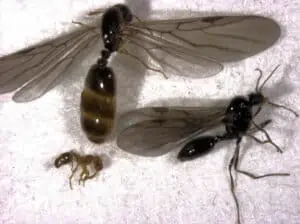Texas Common Pests
Household pests can damage your property and potentially harm your health.
Carpenter Ants are large (1/4 – 1 inch) ants indigenous to many parts of the world. The most likely species to be infesting a house in the United States is the Black carpenter ant. However, there are over a thousand other species in the carpenter ant genus.
Habitat – Resides both outdoors and indoors in moist, decaying or hollow wood.
They cut “galleries” into the wood grain to provide passageways for movement from section to section of the nest. They can leave “sawdust” behind that provides clues to nesting location.
Damage – If this wooden complex happens to be a wall frame within your home, structural damage may result.
Fire Ants size varies from 2 mm to 6 mm (0.12 in to 0.24 in). These different sizes of the ants can all exist in the same nest. They can be distinguished from other ants by their copper brown head and body with a darker abdomen. There are over 280 species of stinging ants worldwide.
Habitat – Fire ants nest in the soil, often near moist areas, such as river banks, pond edges, watered lawns and highway edges. Usually the nest will not be visible as it will be built under objects such as timber, logs, rocks, pavers, bricks, etc. If there is no cover for nesting, dome-shaped mounds will be constructed which can reach heights of 40 cm (15.7 in).
Damage – The venom of a fire ant sting causes stinging and swells into a bump. This can cause much pain and irritation at times, especially when stung repeatedly by several at once.
Cockroaches are among the best-known pest species are the American cockroach, which is about 30 mm (1.2 in) long, the German cockroach, which is about 15 mm (0.59 in) long, the Asian cockroach, which is also about 15 mm (0.59 in) in length, and the Oriental cockroach, which is about 25 mm (0.98 in). Cockroaches have a broad, flattened body and a relatively small head. There are over 4,000 species of cockroaches in the world.
Habitat – Cockroaches live in a wide range of environments around the world. Pest species of cockroaches adapt readily to a variety of environments, but prefer warm conditions found within buildings. Cockroaches leave chemical trails in their feces as well as emitting airborne pheromones for swarming and mating. Other cockroaches will follow these trails to discover sources of food and water, and also discover where other cockroaches are hiding.
Damage – Cockroaches are one of the most commonly noted household pest insects. They feed on human and pet food, and can leave an offensive odor. They can also passively transport microbes on their body surfaces including those that are potentially dangerous to humans, particularly in environments such as hospitals. Cockroaches are linked with allergic reactions in humans.
Fleas are wingless insects whose mouthparts are adapted for piercing skin and sucking blood. Fleas are small (1/16 to1/8-inch (1.5 to 3.3 mm) long), agile, usually dark colored (for example, the reddish-brown of the cat flea), wingless insects with tube-like mouthparts adapted to feeding on the blood of their hosts.
Habitat – Adult fleas must feed on blood before they can become capable of reproduction. Eggs are laid in batches of up to 20 or so, usually on the host itself, which easily roll onto the ground. As such, areas where the host rests and sleeps become one of the primary habitats of eggs and developing fleas.
Damage Besides the intense itching associated with a flea bite they can also act as a vector for disease. For example, fleas transmitted the bubonic plague between rodents and humans by carrying Yersinia pestis bacteria. Murine typhus (endemic typhus) fever, and in some cases Hymenolepiasis (tapeworm) can also be transmitted by fleas.
Termite workers are wingless, white to grayish-white with a round, yellow-brown head and about 6 to 9 mm (1/4 to 3/8 inch) long. Swarmers have straight, bead-like antennae, a thick waist and a pair of long, equal-length wings that break off easily. There are an estimated 4,000 species (about 2,600 taxonomically known) and about 10% of these 4,000 species are economically significant as pests that can cause serious structural damage to buildings, crops or plantation forests. Termites mostly feed on dead plant material, generally in the form of wood, leaf litter, soil, or animal dung.
Habitat – Termites live in colonies that, at maturity, number from several hundred to several million individuals. A typical colony contains nymphs (semi-mature young), workers, soldiers, and reproductive individuals of both genders, sometimes containing several egg-laying queens. Termite workers build and maintain nests to house their colony. These are elaborate structures made using a combination of soil, mud, chewed wood/cellulose, saliva, and feces.
Damage – Due to their wood-eating habits, many termite species can do great damage to unprotected buildings and other wooden structures. Their habit of remaining concealed often results in their presence being undetected until the timbers are severely damaged and exhibit surface changes. Once termites have entered a building, they do not limit themselves to wood; they also damage paper, cloth, carpets, and other cellulosic materials. Often, other soft materials are damaged and may be used for construction. Particles taken from soft plastics, plaster, rubber, and sealants such as silicon rubber and acrylics are often employed in construction. The presences of winged termites or wings that have shed inside a home are signs of a termite infestation.
Spiders are air-breathing chelicerate arthropods that have eight legs, and chelicerae modified into fangs that inject venom. As of 2008, taxonomists have recorded approximately 40,000 spider species, and 109 families. Spiders occur in a large range of sizes. The smallest, Patu Digua from Borneo, are less than 0.37 mm in body length. The largest and heaviest spiders occur among tarantulas, which can have body lengths up to 90 mm (about 3.5 inches) and leg spans up to 250 mm (about 10 inches).
Damage – Spiders do not cause structural damage to homes and business and are more of a nuisance to people, although they will sometimes bite people. Most spiders will only bite humans in self-defense, and few produce worse effects than a mosquito bite or bee-sting. Most of those with medically serious bites, such as recluse spiders and widow spiders, are shy and bite only when they feel threatened, although this can easily arise by accident.
Below are some common and dangerous spiders in Texas
Brown Recluse Spider – Is usually between 6 20 mm (1/4 in and 3/4 in), but may grow larger. It is brown and sometimes an almost deep yellow color and usually has markings on the dorsal side of its cephalothorax, with a black line coming from it that looks like a violin with the neck of the violin pointing to the rear of the spider, resulting in the nicknames fiddle-back spider, brown fiddler or violin spider. Recluse spiders build irregular webs that frequently include a shelter consisting of disorderly threads. These spiders frequently build their webs in woodpiles and sheds, closets, garages, plenum, cellars and other places that are dry and generally undisturbed. Brown recluse bites may produce a range of symptoms known as loxoscelism. There are two types of loxoscelism: cutaneous (skin) and systemic (viscerocutaneous). Most bites are minor with no tissue death. However, a small number of bites produce severe dermonecrotic lesions, and, sometimes, severe systemic symptoms. These symptoms can include organ damage, and occasionally even death; most fatalities are in children under 7 or those with a weaker than normal immune system.
Black Widow Spider – The mature female is around 38 mm (1.5 in) long and 6.4 mm (0.25 in) in diameter. They are well known for the distinctive shiny black color and red coloring in the shape of an hourglass on the ventral (under) side of her very rounded abdomen. The female of the species is known for the fact that she will occasionally eat her mate after reproduction. This highly venomous species is native to the United States of America. The female black widow’s venom is particularly harmful to humans (males almost never bite humans). The injection of venom from this species is a comparatively dangerous or lethal bite.
The Common House Spider – A common house spider is brown in color and its body is about 3/8-inch long. Its abdomen is spherically shaped, and is white to brown in color with several dark markings. Males are smaller than females, and their legs are orange in color. The female’s legs are yellow. This spider is the most common type of comb-footed spider, a group that includes the black widow species. They are urban pests named after the comb-like row of bristles located on the tarsi of their fourth pair of legs. House spiders are common throughout the world, and their webs are most often found in corners, basements, crawl-spaces, under furniture and around windows. The venom is necrotic, causing open, localized wounds that may be slow to heal but despite its aggressive nature, reported bites from this spider are relatively rare.
Rodentia: also known as rodents, are characterized by two continuously growing incisors in the upper and lower jaws that must be kept short by gnawing.
(Example: mouse and rat)
Mouse – Is a small animal that belongs to one of numerous species of rodents. There are about 30 known species of mice in the world. The best-known mouse species is the common house mouse; it is also a popular pet. The American white-footed mouse and the deer mouse also sometimes live in houses. Mice can at times be harmful pests, damaging and eating crops and spreading diseases through their parasites and feces. In western North America, breathing dust that has come in contact with mouse feces has been linked to the deadly hantavirus. The original motivation for the domestication of cats is thought to have been for their predation of mice and their relatives, the rats.
Rat – Is a medium sized, long-tailed rodent of the superfamily Muroidea. ‘True rats’ are members of the genus ‘Rattus’, the most important of which to humans are the black rat, and the brown rat. There are about 50 known species of rats around the world. Many members of other rodent genera and families are also called rats and share many characteristics with true rats. Rats are frequently blamed for damaging food supplies and other goods, or spreading disease.
Need Immediate Help With Pests?
SCHEDULE AN APPOINTMENT WITH US TODAY!






